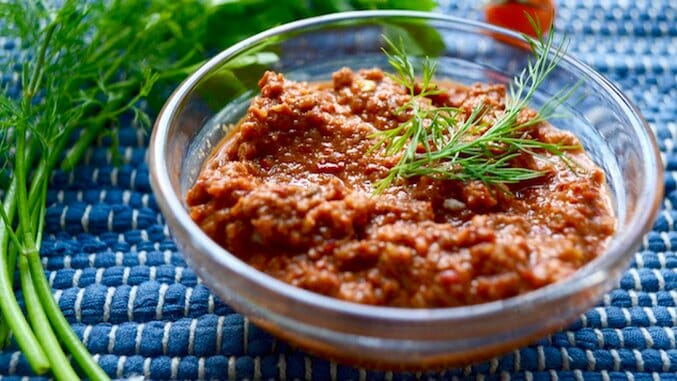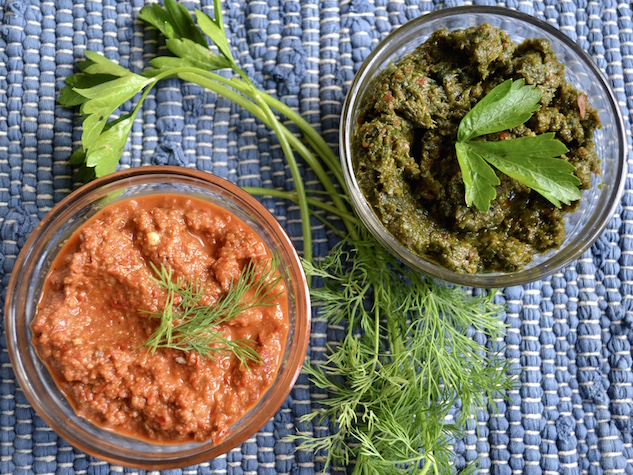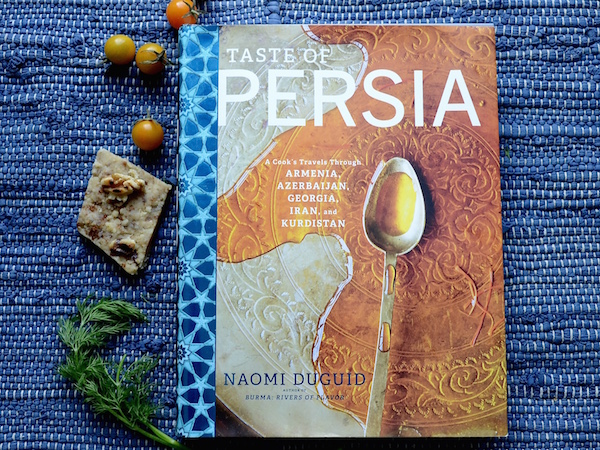
If there is a cookbook author who I would follow anywhere, it is Naomi Duguid. In her latest, Taste of Persia: A Cook’s Travels Through Armenia, Azerbaijan, Georgia, Iran, and Kurdistan, she invites us into the home kitchens of this diverse culinary region. With prose that reflects deep on-the-ground research and the workings of an ever-curious mind, the guide opens a window on to a rich culinary blend.
Cooking through this beautifully photographed cookbook and travelogue, one encounters dishes adapted over the course of empires. Chief among them, perhaps, is Persian Rice (Chelo), a preparation that is specific in technique and glorious in result. Yet the book’s true focus is on the living, breathing people who continue to evolve Persia’s culinary traditions — a group too often overshadowed in conflict-hungry news cycles.
As with her previous book, Burma: Rivers of Flavor, Duguid is masterful in elevating people above their political contexts. “The people are not the government,” she stated elegantly on Toronto’s Breakfast Television one recent morning. Ample evidence of that perspective abounds in this delicious gathering of recipes, where pride in culture shines clear.
For the reader, this approach creates a human connection, and Duguid celebrates her guides at every turn. After preparing Date-Nut Halvah (Hormah Bereshte), it was exciting to discover a photo of Afsar, the recipe’s creator, later in the text. Her Southern Iranian rendition of the classic “sweet” (as translated from the Arabic) is made with wheat flour, differentiating it from the sesame-based version popular in the Arab world.
Packed with thoughtful essayistic interludes and headnotes, the book is a pleasure to read on its own merit. Yet it is best experienced in a fenugreek-scented kitchen with a Tamarind Sharbat in hand — a refreshing drink made with sweet-tart syrup, water and ice. For those eager to explore Persia’s bright flavors and textures, there are revelations to be found. The first for me was this: it is possible to use four heads of garlic in a single recipe and not find it overpowering.

Hands sticky from peeling cloves, I made large batches of Green and Red Ajika over the course of a weekend morning. The green emerges in a soulful shade: a painted reflection of dill, coriander, parsley, Chinese celery and leeks. The red brings together walnuts, cayenne and ripe red peppers (and offers a kick). These Georgian condiments are salty yet fresh, summertime captured. I have swirled them into yogurt as a vegetable dip and transformed them into marinades, thinned with sunflower oil and spiked with vinegar. As Duguid predicts, I have created reasons to use them often.
These are just two of the recipes that anchor the “Flavors and Condiments” chapter, which forms a baseline for all that follows. In the Persian pantry, we find Mint Oil and Saffron Water, golden bright. Spice blends and flavored salts entice. Most revelatory, however, is the easiest to prepare: the fresh herb plate known as Sabzi Khordan. A gathering of whatever is in season, this is the anchor of the Persian table, and it encapsulates the region’s culinary ethos.
In “eating greens” (the literal translation) we find flavor and health, and evidence of a strong hospitality culture. Guests are invited to select what they please.
A number of recipes surprise in their simplicity, incredible tastes and textures emerging from streamlined flavor combinations. A perfect example is Kurdish Black Rice (Birinji Rash), a risotto-like preparation that Duguid aptly describes as astonishing. When Arborio is dressed up with pomegranate molasses, shallots, walnuts, and sunflower oil, plus a little bit of water and sea salt, magic happens. The same can be said for cucumber salad dressed with sumac and dried mint.

In just a few short weeks, Taste of Persia has become a mainstay on my kitchen counter. There are recipes I will prepare again and again. Here, we chat with Naomi Duguid about her experience documenting the region’s cuisine.
Paste: The theme of immersion runs through your work, and you emphasize vulnerability as a means of fully engaging with another culture. How did that sensibility influence your approach to this project?
Naomi Duguid: I think it’s the same everywhere. It’s necessary to be present in any situation you’re in, whether you’re sitting in a shop in Armenia or Iran. It’s a matter of moving forward into the situation. I’m a guest in someone else’s country, so I’m never thinking: “Why do they do it like this?” or “Why does it taste like that?” I never wish that things were different. I’m just being present and figuring out what’s there. It’s also true that Persia is accessible in ways that Burma was not. People aren’t worried about talking to you. People were afraid in Burma. It’s not so much like that now, but it was a bit when I was doing the research.
Paste: Much of Taste of Persia centers on home cooking, creating an intimate experience for the reader. Were people eager to invite you into their kitchens?
ND: I never ask. I make myself present and hope that interesting things happen. For this project, I was in a homestay in Iran, and then in Azerbaijan, Armenia and Georgia. So you’re there, and then you see what comes from it. You always learn things. You might learn how not to make things, but you always learn something.
Paste: In both Burma: Rivers of Flavor and Taste of Persia you are purposeful in how you handle the intersection of culture and politics. How do you decide where to draw the line in terms of what makes it into your books?
ND: I’m interested in the particular and the personal, and in letting that speak. The generalizations and the headlines — that’s other peoples’ interest. I’m interested in that, but I’m not interested in featuring it. You asked me earlier about home cooking. Home cooks are the front line of people cooking in the world, so that’s what’s interesting to write about. The generals or whoever is in charge, that’s about power and money. Enough people write about that already.
Paste: One striking aspect of the book was the interplay between a shared culinary language and localized traditions. Were there surprises in that regard as you traveled?
ND: One of the most surprising things for me was the rice in Kurdistan, and I write quite a bit about that because it’s very different from the rice tradition in Iran. You would think that they would be similar, perhaps, but they’re very, very different. It has nothing to do with the basmati style of rice or the Persian style of rice cooking. Kurds will cook a sort of Kurdish version of biryani with basmati-style rice, but their home rice is more like Mediterranean rice. That was fascinating to me. It’s very delicious and quite different.
Paste: What do you find most compelling about the culinary traditions of Persia, given your broad experience with cuisines around the world?
ND: One thing would be that it’s so not dependent on meat for flavor. Yes, there are kebabs and so on, but if you take those out, you still have an extraordinary repertoire of dishes. It’s also the brilliant use of every kind of flavor — in punchy ways, in subtle ways. It’s really extraordinary. Throughout the region, there is also a wonderful use of grains and beans, and when you say “grains and beans” that might sound dull. In fact, it’s brilliant. I think that’s a measure, with the tart fruits and the fresh herbs, of how the beans go way back. They’re evolving all of the time, but they go way back and they are, in that region, a staple. This is how people have survived. Nuts, fresh herbs, dried herbs, grains, and beans…really, that’s a lot of it. You throw vegetables in there when you have them. It’s really something.
Paste: If a reader were planning a Taste of Persia-themed dinner party, what would you recommend for the menu?
ND: Whatever they are attracted to. Seriously. People should pick something that looks and sounds good to them and do it. Pick a vegetable. Maybe make a soup as a main course, and then have some sides. One thing that’s really easy is any of the kebabs. Meat is substantive. You don’t have to do much to it and it turns out well. What’s really interesting, though, are all of the other things – where people are making use of ingredients that start out as Plain Jane in the pantry and then they turn into Cinderella. Whatever they choose, people should put out an herb plate. There’s nothing better than having fresh bites of things.
Paste: The herb plate says something about the Persian hospitality culture you describe. It changes the experience of eating.
ND: Absolutely — using herbs as a seasoning or palate-cleaner. You can choose to have a bite of this or a bite of that. It’s very special. People may come across this in Vietnamese cuisine as well, when you have pho and there’s a plate of fresh herbs. It’s remarkable, and throughout the region it’s omnipresent. It’s a way of getting fresh, intense, and interesting flavors on the table without effort, and you’re not encroaching them on people. They can choose what they like. I think that’s rather a special way to do it.
Paste: It shows respect for the other.
ND: Also, people think of Iran as a place without freedom. There may not be public freedom in some ways, but in the privacy of your own home there is a lot more freedom than at many dinner tables in North America — where the meal goes down and that’s it. There, you have a number of dishes, and you can pick and choose. You can select fresh herbs. You can season it how you want. There are a lot of possibilities.
Jenn Hall writes about food and culture from a Jersey-side suburb of Philly. Follow along on Instagram and Twitter @jennsarahhall.